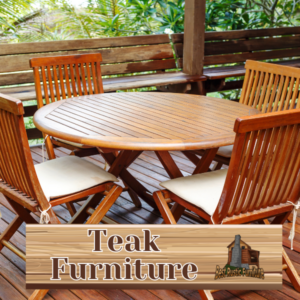
Welcome to our guide on Rustic Furniture Joints! Whether you’re a woodworking enthusiast or simply appreciate the charm of rustic furniture, this article will provide insight into the craft of creating timeless furniture pieces. In this guide, we will explore traditional techniques used to create rustic furniture joints and how you can apply these methods to your own projects.
Key Takeaways:
- Rustic furniture joints are essential for providing strength and stability to furniture pieces
- Traditional techniques involve using hand tools and natural materials
- Common techniques include mortise and tenon joints and log joinery
- Outdoor rustic furniture requires special considerations for joint construction
- DIY tips and tricks can help you achieve professional-looking joints
What are Rustic Furniture Joints?
Rustic furniture joints are connections between different pieces of wood that make up rustic furniture. These joints are vital for providing strength and stability to the furniture, ensuring they last for generations. Rustic furniture joints are created using different traditional woodworking techniques, such as mortise and tenon joints, dowels, and screws.
Mortise and tenon joints are one of the most common and widely used techniques in rustic furniture. This technique involves creating a rectangular hole (the mortise) in one piece of wood and fitting a corresponding projection (the tenon) on another piece of wood into the mortise. The joint is then secured using glue, dowels, or even wooden pegs.
Log joinery is another technique commonly used in creating rustic furniture joints. Logs or thick pieces of wood are used in their natural state to create sturdy connections. They can be notched, stacked, or interlocked to form strong and unique joints without the need for additional fasteners.
Rustic furniture joints can also incorporate natural elements such as tree bark, twigs, or antlers. These elements add a unique and authentic touch to the furniture pieces. Bark, for example, can be used to wrap around joints to provide both aesthetics and increased stability, while twigs and antlers can be incorporated as decorative accents or functional components.
Traditional Techniques for Rustic Furniture Joints
Rustic furniture has a distinct charm that is hard to resist. In addition to the materials used, the joints in rustic furniture play a critical role in providing stability and durability. Traditional techniques are employed in creating these joints, and they have been passed down through generations.
The following are some traditional techniques used for creating rustic furniture joints:
Mortise and Tenon Joints
Mortise and tenon joints are commonly used in rustic furniture due to their strength and longevity. This technique involves cutting a rectangular hole (mortise) in one piece of wood and fitting a corresponding projection (tenon) on another piece of wood into the mortise. The joint is then secured using glue, dowels, or even wooden pegs.
Log Joinery
Log joinery is a technique often used in rustic furniture, especially for creating pieces with a natural, organic look. This technique involves using logs or thick pieces of wood in their natural state to create joints. Logs can be notched, stacked, or interlocked to form sturdy connections, often without the need for additional fasteners.
Natural Elements
Rustic furniture often features natural elements like bark, twigs, or even antlers in the joints. These elements add a unique and authentic touch to the furniture pieces. Bark can be used to wrap around joints to provide both aesthetics and increased stability, while twigs and antlers can be incorporated as decorative accents or functional components.
Using traditional techniques, rustic furniture joints can become works of art themselves. When combined with careful material selection and quality craftsmanship, these joints can make exceptional pieces of furniture that stand the test of time.
Mortise and Tenon Joints in Rustic Furniture
Rustic furniture pieces are known for their charm and durability, and mortise and tenon joints play a crucial role in achieving these characteristics. This traditional technique involves carving a rectangular hole (mortise) in one piece of wood and a corresponding projection (tenon) on another. The tenon is then inserted into the mortise and secured using glue, wooden pegs, or even dowels.
Mortise and tenon joints provide exceptional strength and longevity, making them a popular choice for creating rustic furniture pieces. They also allow for the expansion and contraction of the wood, preventing the joints from becoming loose or weak over time.
In addition to their functional benefits, mortise and tenon joints add elegance and simplicity to the overall design of the furniture. Their clean lines and smooth surfaces contribute to the rustic charm of the piece, making them a favorite among woodworkers and furniture enthusiasts alike.
While this technique can be challenging for beginners, it’s worth the effort to master. With practice and patience, anyone can create beautiful mortise and tenon joints that will stand the test of time in their rustic furniture pieces.
Log Joinery for Rustic Furniture
Rustic furniture often uses natural materials, and log joinery is a perfect example of this. Log joinery involves using logs or thick pieces of wood in their natural state to create joints. By leaving the logs in their natural state, it allows for a more organic look that blends in with the surrounding environment.
Log joinery can take various forms, such as notched, stacked, or interlocked, to form sturdy connections, often without the need for additional fasteners. This technique makes use of the natural shape of the wood, creating unique pieces of furniture that have their organic charm.
Logs can be stacked to create a sturdy foundation that supports a tabletop or seating surface. To further enhance the structural integrity of the piece, smaller logs can be used to create cross-braces or diagonals for increased stability.
One of the most significant advantages of log joinery is the increased durability that comes with it. When logs are used for joints, they have a natural strength that makes them more resistant to the elements. Log joinery is perfect for outdoor furniture pieces, where exposure to the elements can cause other types of joints to weaken over time.
When using log joinery, you’ll need to ensure that the logs used are straight, sturdy, and free from rot or pests, to prevent issues with stability or longevity. The logs should also be of a suitable size for the joint they’ll create to ensure the right amount of support and stability.
Log joinery is a versatile technique that works well in a range of furniture styles. From warm and cozy log cabins to rustic modern homes, it’s a great way to add a touch of nature and organic beauty to any space.
Incorporating Natural Elements in Rustic Furniture Joints
Rustic furniture is all about embracing the earthy, natural charm of wood. But what if you could take that authenticity to the next level? Incorporating natural elements like bark, twigs, and antlers into your rustic furniture joints can add a one-of-a-kind touch that sets your furniture apart from the rest.
One way to incorporate natural elements is by using strips of bark to wrap around joints. This not only adds an aesthetically pleasing touch but also increases stability. Similarly, using twigs or branches as decorative accents or even functional components can be a unique addition to your rustic furniture piece.
Antlers, which often have a naturally curved shape, can also be incorporated into joints. They can be used as decorative accents, such as being attached to the back of a chair, or functional components, such as being used as the legs of a table.
Remember that when using natural elements in your joints, it’s important to ensure they are dried and treated appropriately to prevent decay or insect damage.
Joinery Techniques Beyond Woodworking
While traditional woodworking techniques play a significant role in creating rustic furniture joints, other materials can also be used in combination to enhance the overall strength and durability of the furniture.
One popular choice is metal fasteners like screws, nails, and lag bolts, which can be used in conjunction with traditional woodworking joints to reinforce the structure. However, it’s essential to use the right type of fasteners and to ensure they are properly installed to avoid weakening the joint or compromising the aesthetics.
Another option is the use of natural materials like rawhide or sinew-based cordage. These materials have been used in indigenous cultures for centuries and offer both functional and decorative benefits. For instance, wrapping cordage around a joint can increase stability and provide a unique touch to the furniture piece.
Some contemporary furniture makers have also experimented with resin-based adhesives or epoxy to create strong, long-lasting joints. These materials offer a modern twist on traditional joints and are particularly suitable for high-stress areas like chair legs or tabletops.
Combining Materials for Joinery
Combining different materials in joinery can create interesting and visually striking pieces of furniture. For example, combining metal and wood can create a bold and modern look, while adding leather or fabric can soften the overall aesthetic.
When combining materials, it’s important to consider the practical aspects of the furniture piece, such as weight, stability, and weather resistance. For outdoor furniture, combining wood and metal can provide the necessary durability and protection against the elements.
| Material Combination | Benefits |
|---|---|
| Wood and Metal | Durable and weather-resistant |
| Leather and Wood | Softens the overall aesthetic, suitable for indoor furniture |
| Fabric and Wood | Adds color and texture to the furniture piece, suitable for indoor furniture |
Experimenting with different materials can provide endless possibilities for creating unique and personalized furniture pieces. However, it’s essential to balance creativity with practicality to ensure the final product is both functional and visually appealing.
Finishing and Maintaining Rustic Furniture Joints
After creating rustic furniture joints, it’s essential to finish and maintain them properly to ensure the longevity of the furniture. Proper finishing not only enhances the aesthetic appeal of the furniture but also protects the joints from wear and tear due to regular use. Here are some tips to help you finish and maintain your rustic furniture joints:
- Sanding: Sand the joints to remove any rough edges and create a smooth surface for finishing. Use a fine grit sandpaper to avoid damaging the joints.
- Staining: Apply a wood stain to the joints to enhance the natural color and grain of the wood. Choose a stain that complements the overall look of the furniture.
- Sealing: Use wood glue or epoxy to seal the joints and prevent any moisture from seeping in. This step is especially crucial for furniture that will be placed in humid or wet environments.
- Maintenance: Regularly inspect the joints for any signs of wear and tear, such as cracks or wobbling. Use a furniture polish to protect the joints from dust and dirt. Avoid exposing the furniture to direct sunlight or extreme temperatures.
By following these tips, you can ensure that your rustic furniture joints remain sturdy and beautiful for years to come.
DIY Rustic Furniture Joints: Tips and Tricks
If you’re interested in creating your own rustic furniture, DIY joints are a great way to personalize your projects. Here are some tips and tricks for achieving professional-looking joints:
Mortise and Tenon Joints
The mortise and tenon joint is a popular technique for creating strong and sturdy connections in rustic furniture. To create a mortise and tenon joint, start by measuring and marking the corresponding pieces of wood. Cut the mortise using a chisel, making sure it’s deep enough to allow the tenon to fit. Use a saw to create the tenon to the correct size, and sand it to ensure a snug fit into the mortise. Once the pieces are securely in place, apply glue and any additional fasteners, such as wooden pegs or dowels, for extra stability.
Log Joinery
Log joinery is often used for creating rustic furniture with a natural, organic look. To create log joinery, start by selecting logs that are the same diameter and length. Use a chainsaw or handsaw to notch the logs at the desired angle, so they fit together snugly. Stack the logs together and secure them with wood glue or wooden pegs for added stability.
Using Natural Elements
Incorporating natural elements like bark or twigs can add an authentic touch to rustic furniture joints. Use bark to wrap around joints or use twigs and antlers as decorative accents or functional components. When using natural elements, it’s important to make sure they’re securely attached to the furniture and won’t cause any stability or safety issues.
Finishing and Maintenance
Once the joints are created, it’s important to finish and maintain them properly. Sand the joints to create a smooth surface, apply a suitable stain or sealer to enhance the wood’s natural beauty and protect it from wear and tear. Regular maintenance, such as tightening screws or replacing wooden pegs, can also help keep your furniture pieces looking their best.
Necessary Tools
Some of the necessary tools for creating rustic furniture joints include saws, chisels, and drill bits. Make sure you have the right tools for the job and take the time to learn proper safety techniques for using them.
Step-by-Step Guidance
For specific guidance on creating popular rustic furniture pieces like coffee tables, benches, or side tables, consult woodworking guides or tutorials. These resources can provide step-by-step instructions and helpful tips for creating professional-looking furniture pieces.
Overall, creating DIY rustic furniture joints requires patience, skill, and attention to detail. But with the right tools and techniques, you can achieve beautiful and functional pieces that showcase the natural beauty of wood and the mastery of traditional woodworking techniques.
Outdoor Rustic Furniture Joints: Considerations and Techniques
Creating rustic furniture for outdoor use presents a set of unique challenges that require specific considerations and techniques. Exposure to moisture, temperature changes, and UV rays can cause wood to deteriorate over time, making it critical to select the right species and finishing techniques.
Wood Species for Outdoor Rustic Furniture
Choosing the right wood species is crucial for outdoor furniture to withstand the elements. Cedar, redwood, and teak are all great choices due to their natural resistance to decay and insect damage. While oak and maple are durable, they are prone to rotting over time and require extra care.
Protective Finishes for Outdoor Rustic Furniture
Applying a protective finish to outdoor rustic furniture is necessary to enhance its weather resistance and prevent rotting. Water-based finishes, such as acrylics, are an excellent option for outdoor use since they dry clear and do not yellow over time. Oil-based finishes, such as linseed oil or tung oil, also work well and provide a natural look. Some experts recommend using a combination of both finishes, allowing the oil to penetrate the wood and the acrylic to provide a protective layer on top.
Joinery Techniques for Outdoor Rustic Furniture
Due to the exposure to the weather, outdoor rustic furniture joints require extra reinforcement to withstand wear and tear. Mortise and tenon joints are a great option for outdoor furniture since they offer strength and stability. Dowels and screws can also be used in combination with mortise and tenon joints for added durability. However, avoid using metal fasteners that can cause the wood to split over time.
Regular Maintenance for Outdoor Rustic Furniture Joints
Regular maintenance is crucial to prolong the life of outdoor rustic furniture. Sanding the joints and applying a fresh coat of finish every year can help prevent cracking and shrinking of the wood. It’s also essential to store the furniture in a dry area during the off-season to avoid excess moisture and sunlight exposure.
By following these considerations and techniques, you can create beautiful and durable outdoor rustic furniture to enjoy for years to come.
Embracing the Rustic Charm: Applying Rustic Furniture Joints
There’s something undeniably charming about rustic furniture. The natural warmth of wood, the timeless appeal of traditional techniques, and the craftsmanship that goes into creating each piece make rustic furniture an excellent addition to any home decor.
One of the key features of rustic furniture is the joints. The rustic charm of these pieces comes from the joints’ imperfections, which are often the result of the craft’s organic, handmade nature. When incorporating rustic furniture into your home, it’s essential to highlight these joints and celebrate the pieces’ uniqueness.
For example, a coffee table with mortise and tenon joints can be showcased with a glass top, allowing the joints to be visible and appreciated while providing a flat surface for decor. Alternatively, a natural bark-wrapped joint can add a pop of texture and authenticity to a rustic bench or side table.
When designing a space with rustic furniture, it’s essential to balance the rustic elements with other design elements to create a cohesive look. Rustic furniture pairs well with natural materials like stone and leather and can be balanced out with modern touches like metal accents and neutral colors.
Ultimately, embracing the rustic charm of furniture joints means appreciating the beauty of imperfection and celebrating the artistry that goes into creating these timeless pieces. So go ahead and add a touch of rustic elegance to your home with furniture that showcases the mastery of rustic furniture joints.
Conclusion
In conclusion, rustic furniture joints are a beautiful and functional part of rustic furniture that add a unique charm to any space. These joints are created using traditional woodworking techniques like mortise and tenon joints, log joinery, and incorporating natural elements like bark and twigs. Other materials like metal fasteners can also be used alongside woodworking joints to enhance the furniture’s structural integrity.
To ensure the longevity of rustic furniture joints, it’s essential to finish and maintain them properly, using techniques like sanding, staining, and wood glue or epoxy to seal the joints. Regular maintenance is also necessary to prevent issues like wood shrinkage or wobbling joints.
For those interested in creating their own rustic furniture, this guide offers tips and tricks for achieving professional-looking joints using the necessary tools and step-by-step guidance. When it comes to outdoor rustic furniture, special considerations must be taken into account, such as using suitable wood species, protective finishes, and appropriate joinery methods.
Overall, rustic furniture joints are a testament to the skill and artistry of traditional woodcraft and should be appreciated for their beauty and durability. Whether you’re a woodworking enthusiast or someone looking to add rustic charm to your home decor, understanding these joints will help you appreciate the mastery behind each piece of rustic furniture.
FAQ
What are rustic furniture joints?
Rustic furniture joints are the connections between different pieces of wood in rustic furniture. These joints provide strength and stability to the overall structure and are often created using traditional woodworking techniques.
What are some traditional techniques for creating rustic furniture joints?
Traditional techniques for creating rustic furniture joints involve using hand tools and working with natural materials. Some common techniques include mortise and tenon joints, log joinery, and incorporating natural elements like bark and twigs.
How are mortise and tenon joints used in rustic furniture?
Mortise and tenon joints are widely used in rustic furniture due to their strength and longevity. This technique involves cutting a rectangular hole (mortise) in one piece of wood and fitting a corresponding projection (tenon) on another piece of wood into the mortise. The joint is then secured using glue, dowels, or wooden pegs.
What is log joinery and how is it used in rustic furniture?
Log joinery is a technique commonly used in rustic furniture to create a natural, organic look. This technique involves using logs or thick pieces of wood in their natural state to form joints. Logs can be notched, stacked, or interlocked to create sturdy connections without the need for additional fasteners.
How can natural elements be incorporated into rustic furniture joints?
Rustic furniture often features natural elements like bark, twigs, or even antlers in the joints. These elements can be used for both aesthetics and increased stability. Bark can be wrapped around joints, while twigs and antlers can be incorporated as decorative accents or functional components.
Can joinery techniques beyond woodworking be used in rustic furniture?
Yes, while woodworking techniques are commonly used in creating rustic furniture joints, other techniques can be employed as well. Metal fasteners like screws, nails, and lag bolts can be used in combination with traditional woodworking joints to enhance the structural integrity of the furniture.
How should rustic furniture joints be finished and maintained?
Once the joints are created, it’s important to finish and maintain them properly to ensure the longevity of the furniture. Techniques like sanding, staining, and using wood glue or epoxy to seal the joints can be employed. Regular maintenance is also essential to prevent issues like wood shrinkage or wobbling joints.
Are there any tips and tricks for creating DIY rustic furniture joints?
Yes, this section provides helpful tips and tricks for achieving professional-looking joints in DIY rustic furniture projects. It discusses the necessary tools needed for different joinery techniques and offers step-by-step guidance on creating popular rustic furniture pieces like coffee tables, benches, or side tables.
What considerations and techniques are important for outdoor rustic furniture joints?
Outdoor rustic furniture requires special considerations due to exposure to the elements. This section explores the unique challenges faced when crafting joints for outdoor furniture and suggests techniques to enhance durability and weather resistance. It discusses suitable wood species, protective finishes, and appropriate joinery methods for outdoor use.
How can rustic furniture joints be incorporated into home decor?
Rustic furniture joints add a distinct charm to any space. This section explores how to incorporate rustic furniture pieces with beautiful joints into home decor. It provides inspiration and ideas for showcasing the craftsmanship of these joints, from accent tables to dining room tables.






